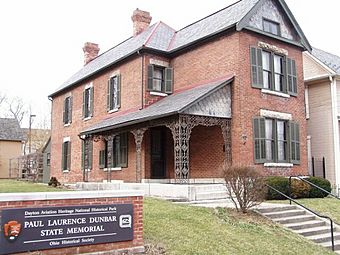Paul Laurence Dunbar House facts for kids
|
Paul Laurence Dunbar House
|
|

Paul Laurence Dunbar Home
|
|
| Location | 219 Paul Laurence Dunbar Street, Dayton, Ohio |
|---|---|
| Built | 1894 |
| NRHP reference No. | 66000619 |
Quick facts for kids Significant dates |
|
| Added to NRHP | October 15, 1966 |
| Designated NHL | December 29, 1962 |
The Paul Laurence Dunbar House was the home of the famous poet Paul Laurence Dunbar from 1904 to 1906. It is located in Dayton, Ohio. Today, it is a special historic house museum that you can visit.
The state of Ohio owns this house. It is managed by Dayton History for the Ohio Historical Society. This important house is also part of the Dayton Aviation Heritage National Historical Park. You can find it at 219 Paul Laurence Dunbar Street in Dayton.
Contents
The Story of Dunbar's Home
Paul Laurence Dunbar had a strong connection to Dayton, Ohio. He was born there in 1872. His parents had been enslaved people before he was born.
Dunbar's first poems were printed in the Dayton Herald newspaper in 1888. His very first book of poems, called Oak and Ivy, was published in Dayton in 1892.
After working as an elevator operator in Dayton, Dunbar became more successful with his writing. He then took a job in Washington, D.C., at the Library of Congress.
How Dunbar Got the House
Dunbar bought this house for his mother, Matilda Dunbar, in June 1904. It is a brick house with eight rooms on a quiet street.
When Dunbar and his wife, Alice Ruth Moore, separated in 1902, he moved into the house with his mother.
By the time Dunbar moved into the house, he was not well. He passed away in this home in 1906. A black wreath was placed on the front door to show that he had died.
After Dunbar's Passing
After Paul Laurence Dunbar died, his mother Matilda continued to live in the house. She carefully kept his books, writings, and study just as he had left them.
It was reported that Matilda would host an open house every year on June 27. This was the day her son was born. Matilda Dunbar lived in the house until she passed away on February 24, 1934.
Preserving History: The House Today
The state of Ohio bought the home in 1936. In that same year, it became the first state memorial dedicated to an African-American person.
The house was recognized as a National Historic Landmark in 1962. Later, in 1992, it became part of the Dayton Aviation Heritage National Historical Park. It is also a key part of the National Aviation Heritage Area.
Today, there is a visitors center next to the house. It has displays with items related to Dunbar's life and his amazing work. The property also includes an old barn.



